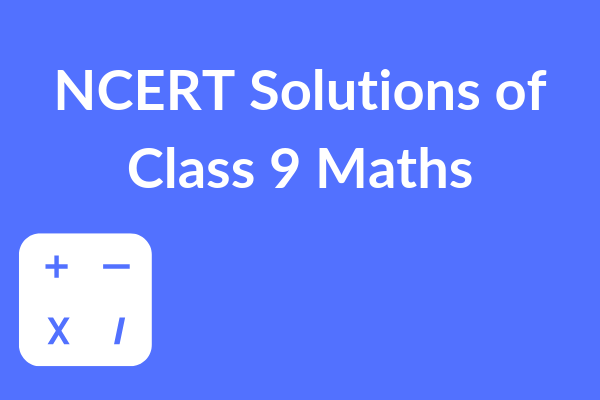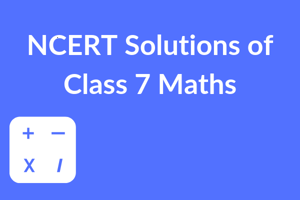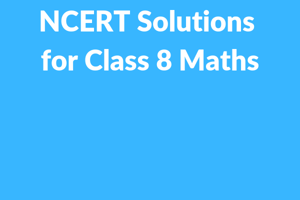The 10th class is an important milestone in one’s educational journey. It is often a turning point...
9th Standard Maths CBSE Updated Chapters & Syllabus 2020-2021
The 9th class marks the beginning of an important phase in every student’s life. 9th and 10th standards are considered to be two of the most crucial classes in school life. While all the classes and all the subjects have their importance, 9th standard maths play a key role in the life of students who especially want to go in the fields of maths and science in their careers. Class 9 maths contains some important lessons which will help students greatly in their later classes.
As per the CBSE system, class 9th and 10th are the two very important classes that strengthen the base of every student in all the chapters. After this, the student can decide his or her stream and pursue the subjects that they are most interested in. If one wants to pursue science or commerce, he/she should pay extra attention to 9th standard maths.

The NCERT maths book class 9 is divided into 6 units. Each unit contains a varied number of lessons. The unit is precisely the broader category in mathematics and the lessons in each unit look at the precise concepts of that category. The 6 units in the class 9 maths book are:
Unit I – Number System
Unit II – Algebra
Unit III – Coordinate Geometry
Unit IV – Geometry
Unit V – Mensuration
Unit VI – Statistics and Probability
Now, having known that, let us look at what each of these units contains individually. This will also give us a chapter-wise view and description of the whole syllabus.
Blog Contents
Unit I – Number System
The first unit of the class 9 maths consists of only one chapter that talks about Real Numbers. Hence, the first chapter of the NCERT maths book class 9 is named as Real Numbers. In this chapter, students learn the following main topics:
- Representation of terminating / non-terminating recurring decimals on the number line through successive magnification.
- Explaining that every real number is represented by a unique point on the number line and conversely, viz. every point on the number line represents a unique real number.
- Defining the nth root of a real number.
- Rationalization of real numbers of the type where denominator contains square roots and identities.
- Recalling the knowledge of laws of exponents with integral powers and applying that knowledge to complex questions.
Unit II – Algebra
The second unit of 9th grade maths named Algebra contains two chapters namely, Polynomials and Linear Equation in Two Variables. The main topics covered in the two chapters are crucial and important concepts in Algebraic mathematics.
Polynomials
We can all recall studying polynomials as an interesting, subject. This is the second chapter in the ncert 9th class. This chapter introduces the students to the Definition of a polynomial in one variable. It helps them understand better with examples.
The next topic in this second chapter of the ‘class 9 math syllabus’ talks about the coefficients of a polynomial followed by terms of a polynomial and zero polynomial. The consecutive topics are:
- Degree of a polynomial
- Constant
- Linear, quadratic and cubic polynomials
- Monomials, binomials and trinomials
- Factors and Multiples
- Zeroes of a polynomial
- Factorization of ax2 + bx + c, a ≠ 0 where a, b and c are real numbers
- Factor Theorem
- Verifying the algebraic expressions and identities.
Linear Equation in Two variables
In the previous class, students learned to solve the linear equation in one variable. In 9th grade maths, students will learn to solve the linear equation in two variables. This is the third chapter in NCERT maths book class 9. The chapter starts with recalling the linear equation in one variable and an introduction to the linear equation in two variables. The consecutive topics covered are:
- linear equations of the type ax + by + c = 0
- Proving that a linear equation in two variables has infinitely many solutions
- Justification of the above statement
- Ordered pairs of real numbers
- Plotting the solutions on the line
- Graph of the linear equation in two variables
- Ratio and proportions
- Examples and problems from the real-life
Unit III – Coordinate Geometry
The third unit of the class 9 math syllabus is Coordinate geometry. This unit is an interesting yet important part of the class 9 math question paper. This unit contains only one chapter which itself is named coordinate geometry. The main topics covered here are:
- The Cartesian plane
- Coordinates of a point
- Names and terms associated with the coordinate plane
- Notations
- Plotting points in the plane
Unit IV – Geometry
The third unit of 9th standard maths is Geometry. Geometry is a very practical and fun topic. Students often find it fun, easy, and interesting as they can get their hands on some practice drawing with the geometrical instruments. This unit of class 9 math contains 5 chapters and is perhaps the longest unit in the syllabus. Let us look at each chapter in this unit and the topics they discuss individually.
Lines and Angles
This chapter is largely based on Motivate and Prove concepts and questions. The main topics here are:
- (Motivate) If a ray stands on a line, then the sum of the two adjacent angles so formed is 180 degrees and the converse.
- (Prove) If two lines intersect, vertically opposite angles are equal
- (Motivate) Results on corresponding angles, alternate angles, interior angles when a transversal intersects two parallel lines.
- (Motivate) Lines that are parallel to a given line are parallel.
- (Prove) The sum of the angles of a triangle is 180 degrees.
- (Motivate) If a side of a triangle is produced, the exterior angle so formed is equal to the sum of the two interior opposite angles.
Triangles
This chapter is largely based on Motivate and Prove concepts and questions. The main topics here are:
- (Motivate) Two triangles are congruent if any two sides and the included angle of one triangle is equal to any two sides and the included angle of the other triangle (SAS Congruence)
- (Prove) Two triangles are congruent if any two angles and the included side of one triangle is equal to any two angles and the included side of the other triangle (ASA Congruence)
- (Motivate) Two triangles are congruent if the three sides of one triangle are equal to three sides of the other triangle (SSS Congruence)
- (Motivate) Two right triangles are congruent if the hypotenuse and a side of one triangle are equal (respectively) to the hypotenuse and a side of the other triangle
- (Prove) The angles opposite to equal sides of a triangle are equal
- (Motivate) The sides opposite to equal angles of a triangle are equal
- (Motivate) Triangle inequalities and relation between ‘angle and facing side’ inequalities in triangles
Quadrilaterals
This chapter is largely based on Motivate and Prove concepts and questions. The main topics here are:
- (Prove) The diagonal divides a parallelogram into two congruent triangles
- (Motivate) In a parallelogram opposite sides are equal, and conversely
- (Motivate) In a parallelogram, opposite angles are equal, and conversely
- (Motivate) A quadrilateral is a parallelogram if a pair of its opposite sides are parallel and equal
- (Motivate) In a parallelogram, the diagonals bisect each other and conversely
- (Motivate) In a triangle, the line segment joining the midpoints of any two sides is parallel to the third side and (motivate) its converse
Circles
Apart from some basic concepts like circumference, radius, diameter, arc, chord, segment, secant, subtended angle, and sector, the circle largely is based on motivates and proves.
- (Prove) Equal chords of a circle subtend equal angles at the center and (motivate) its converse
- (Motivate) The perpendicular from the center of a circle to a chord bisects the chord and conversely, the line drawn through the center of a circle to bisect a chord is perpendicular to the chord
- (Motivate) There is one and only one circle passing through three given non-collinear points
- (Motivate) Equal chords of a circle (or of congruent circles) are equidistant from the center (or their respective centers) and conversely
- (Prove) The angle subtended by an arc at the center is double the angle subtended by it at any point on the remaining part of the circle
- (Motivate) Angles in the same segment of a circle are equal
- (Motivate) If a line segment joining two points subtends an equal angle at two other points lying on the same side of the line containing the segment, the four points lie on a circle.
- (Motivate) The sum of either of the pair of the opposite angles of a cyclic quadrilateral is 180o and its converse.
Constructions
As the name suggests, this chapter in class 9 maths includes some practical mathematics. Students will find this as the most interesting chapter in the geometry unit. Here, students will learn how to construct angles of various degrees without using a protractor to measure. They can use the protractor later to verify their constructed angles. They will also learn to construct the bisector of a line segment. The later section of the chapter deals with the Construction of a triangle when its base, sum/difference of the other two sides, and one base angle are given.
Unit V – Mensuration
The second last unit of the 9th standard maths is about Mensuration. Mensuration is a well-known and important chapter in mathematics which also has some real-life implementation. The Mensuration unit of class 9 maths has two chapters namely Areas and Surface areas and Volumes.
The first chapter of this unit, Area, has some basic concepts of areas as studied in the earlier classes. In addition to this, it also has a very important concept of Heron’s Formula. Here, students will learn to find the area of a triangle using Heron’s formula and they will also learn to prove it.
Unit VI – Statistics and Probability
The last unit in the “9th standard maths” syllabus is about the statistics and the probability. This unit has two chapters. The first chapter of this unit is about statistics alone while the second one discusses probability.
The first chapter of the last unit of “class 9 maths”, Statistics, introduces students to the term and discusses the collection of data. It further discusses the presentation of the data that can be done in tabular form, grouped/ungrouped, and bar graphs.
.png?width=100&height=100&name=Kapdec%20Logo%20(400px).png)


